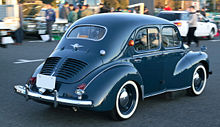Hino-Renault 4CV
| Hino-Renault | |
|---|---|
|
Hino Renault 4CV (1962)
|
|
| PA62 日野·ルノー4CV |
|
| Production period: | 1953-1961 |
| Class : | Small car |
| Body versions : | limousine |
| Engines: |
Petrol engines : 0.75 liters (12.5–19 kW) |
| Length: | 3663 mm |
| Width: | 1430 mm |
| Height: | 1470 mm |
| Wheelbase : | |
| Empty weight : | 600-870 kg |
| successor | Hino Contessa |
The Hino-Renault 4CV was a Japanese license of the Renault 4CV in the right-hand drive version . Hino Motors Ltd. tried at the beginning of the 1950s to establish a joint venture with the then state-owned French automobile and commercial vehicle manufacturer Renault . The main products of Hino Motors were trucks and buses , and the company also managed to get started in car production with the Hino-Renault 4CV, which was built from 1953.
In March 1953, Hino Motors signed a cooperation agreement with the Régie Nationale des Usines Renault (State Administration of Renault Works) for technical support and in-house production of the 4CV for left-hand traffic in Japan. While at the beginning the vehicle parts still had to be imported from France, Hino finally organized the production of the parts and engines in domestic companies. However, due to various complications from outside companies, this goal was not achieved until March 1958. Since then, the past has been referred to within the company as “the evil path”. Until then, it often happened that parts didn't go together at all. The interior and exterior could also show considerable differences, depending on which supplier the vehicle parts came from.
After that, production improved: the engines manufactured under a Renault license were reworked in-house and their performance increased. Different body versions were now also available. The entry-level model was the previously known 4CV. Now taxi and police versions were also included in the delivery program. In Japan, the Hino-Renault 4CV became known and popular under the nickname "Tortoise". The 4CV was built in Japan - as in France - until 1961 and then replaced by the in-house design Hino Contessa . With the hostile takeover by Toyota Motor Corp. In 1966, the new parent company prohibited the production of car models under the Hino brand.
Various engines with a displacement of 750 cm³ were available for the drive in the Hino-Renault 4CV. In the basic model, the engine had an output of 17 hp. In March 1958 the engine was equipped with an electric starter and the engine output for all other model versions was increased to 19.5 hp. In 1961, variants with 21 and 26 hp finally followed.
Up to the end of production of the Hino-Renault 4CV, 1,105,547 units of this vehicle model had been built.
Sources and web links
- Toyota Motor Corporation Official Website (Japanese)


